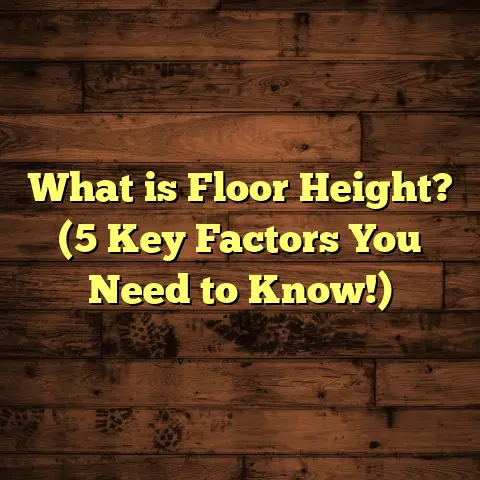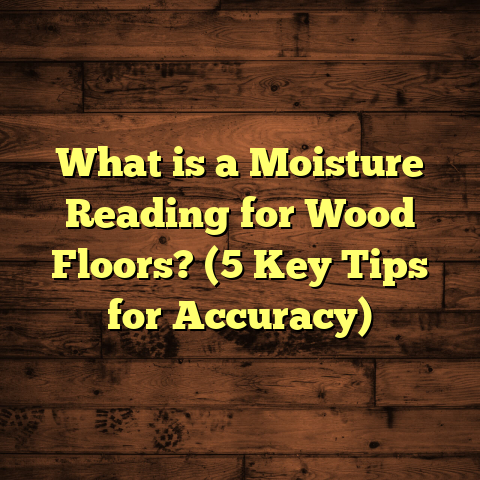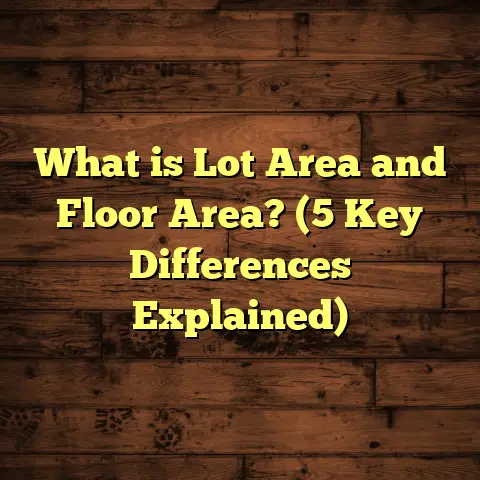What is Floor Waxing? (3 Benefits for a Gleaming Finish)
What is Floor Waxing?
I remember the first time I gave my floors a proper waxing. The transformation was nothing short of magical. What had been a dull, tired surface suddenly gleamed with life and warmth. It was like I had uncovered a hidden layer of beauty beneath all that wear and tear. That’s what floor waxing does—it breathes new life into your floors.
Floor waxing is the process of applying a protective wax coating to your floor’s surface. This layer seals, protects, and enhances the floor’s appearance by adding shine and depth. Typically, it involves spreading a wax compound over the floor, letting it dry, and then buffing it to a smooth, glossy finish.
The wax acts as a shield against scratches, stains, moisture, and dirt. It makes cleaning easier and prolongs the life of your floors. But waxing isn’t just about looks—it’s about preserving your investment.
The Evolution of Floor Waxing: A Brief History
Floor waxing isn’t new. In fact, its roots trace back centuries. Long before synthetic coatings existed, people used natural waxes like beeswax to protect wooden surfaces. Beeswax was prized for its durability and natural shine.
With industrialization came the development of synthetic waxes such as acrylic and polyethylene-based products. These modern waxes provided longer-lasting protection and were easier to apply. By the mid-20th century, floor waxing became a standard maintenance practice for homes, businesses, and public buildings.
Even today, while some modern flooring finishes like polyurethane have reduced the need for waxing in certain cases, waxing remains popular for many floor types—especially hardwood, vinyl, and linoleum.
Why I Became Passionate About Floor Waxing
When I started working in flooring years ago, I was frustrated by how quickly new floors lost their shine. Scratches appeared within weeks; dirt settled into grooves; spills left stains despite regular cleaning.
Waxing felt like a secret weapon—a way to protect floors so they stayed beautiful longer. After experimenting with different waxes and techniques on my own home and clients’ properties, I became convinced that proper floor waxing was one of the best investments anyone could make in their home or business.
It’s not always easy, though. I’ve learned the hard way that waxing takes patience, precision, and knowledge about your specific flooring material. You can’t just slap on any wax or rush the process and expect perfect results.
Types of Floor Waxes: Which One Is Right for You?
Choosing the right wax is critical. Different floors require different types of wax to avoid damage or poor results.
Natural Waxes
- Beeswax: Derived from honeybees, it’s one of the oldest waxes used for floors. Beeswax offers a warm glow and natural protection but requires frequent reapplication as it wears off faster than synthetic options.
- Carnauba Wax: Extracted from Brazilian palm leaves, carnauba wax is harder than beeswax and produces a tougher finish with high gloss. It’s often blended with beeswax for better durability.
Synthetic Waxes
- Acrylic Wax: Popular for vinyl, linoleum, and some sealed wood floors. Acrylic wax dries quickly and provides good protection with a shiny finish.
- Polyethylene Wax: Offers excellent durability on commercial floors but can be more difficult to apply evenly.
- Silicone-Based Waxes: Provide water resistance but may interfere with future refinishing if not removed properly.
Paste vs. Liquid vs. Spray
- Paste Waxes: Thick and durable; give a deep shine but take longer to apply and buff.
- Liquid Waxes: Easier to apply; dry relatively fast but may require more frequent coats.
- Spray Waxes: Quick touch-ups but less durable than paste or liquid forms.
In my experience, paste wax works best for hardwood floors needing serious restoration. For regular maintenance on vinyl or linoleum, liquid acrylic wax is convenient and effective.
Tools and Materials Needed for Floor Waxing
Before you start waxing, having the right tools is essential.
- Floor Cleaner: Use pH-neutral cleaners designed for your floor type.
- Mop or Microfiber Cloth: For applying cleaner and removing dust.
- Wax Applicator Pads: Soft cloths or foam applicators spread wax evenly.
- Buffing Machine or Polisher: Speeds up buffing for a mirror-like finish.
- Protective Gear: Gloves and masks if working with solvent-based waxes.
- Vacuum or Broom: To remove debris before waxing.
- Floor Stripper (optional): Removes old wax layers if necessary.
I always recommend investing in a quality buffer if you’re waxing large areas regularly. It cuts down on manual labor and produces superior shine.
Step-by-Step Floor Waxing Guide
Let me walk you through my detailed process that ensures success every time:
Step 1: Clear the Room
Remove all furniture and rugs from the area you plan to wax. Any objects left behind can cause uneven application or damage during buffing.
Step 2: Thorough Cleaning
Sweep or vacuum the floor thoroughly to remove dust and grit. Use a professional-grade cleaner appropriate for your floor type to mop the entire surface. Avoid soap-based products that leave residue.
If your floor has old wax buildup or stubborn stains, consider using a floor stripper before moving forward.
Step 3: Dry Completely
Make sure your floor is completely dry before applying wax. Moisture trapped under the wax can cause bubbling or peeling later on.
Step 4: Apply Thin Coats of Wax
Using your applicator pad or mop designed for waxing, apply a thin layer of wax evenly across the floor. Avoid thick spots that take longer to dry or cause streaking.
Work in small sections to maintain control over coverage.
Step 5: Let It Dry Completely
Allow each coat to dry thoroughly according to product instructions—usually 20 minutes to an hour.
Step 6: Buff After Each Coat
Using a soft cloth or buffer machine set at low speed, buff each coat once dry. Buffing removes excess wax and enhances shine.
Step 7: Repeat Application (2-3 Coats)
For best results, apply two to three thin coats of wax with buffing in between each. Multiple thin layers produce a more durable finish than one thick coat.
Step 8: Final Buffing
After the last coat dries completely (often overnight), give the entire surface one final buff with medium to high-speed buffer or microfiber cloth.
This step brings out maximum gloss.
I typically spend about 4-5 hours on a standard 300 square foot room following this process—from prep through final buffing—but the results are worth every minute.
What Can Go Wrong? Common Challenges With Floor Waxing
I’m honest about the downsides because knowing them helps avoid costly mistakes:
Over-Waxing
Adding too many layers over time causes buildup that looks dull or cloudy instead of shiny. Floors become sticky or easily scuffed because excess wax softens rather than hardens.
If buildup occurs, you must strip all layers down to bare wood or tile before re-waxing—an involved process that can be messy and expensive.
Using Incompatible Wax
Applying wax over polyurethane or other modern sealants can cause peeling or bubbling because these finishes don’t bond well with traditional waxes.
Always test a small inconspicuous area before full application if you’re unsure about your floor’s finish.
Poor Surface Preparation
Wax sticks best to clean surfaces. Dirt, oils, or old wax residues prevent adhesion leading to patchy results or early flaking.
Incorrect Application Technique
Applying thick coats or not buffing properly results in streaks, uneven sheen, or sticky patches.
Environmental Conditions
High humidity slows drying times; dust settles on wet wax causing rough texture; low temperatures prevent proper curing.
Controlling room conditions helps ensure smooth results.
One time I rushed through prep on a client’s hardwood floor because they wanted quick results before guests arrived. The wax never fully bonded due to leftover dirt beneath layers—result was blotchy finish needing complete redo later. Lesson learned!
Maintenance Tips for Waxed Floors
Waxed floors are not maintenance-free; they just require less intensive care than bare floors.
- Sweep daily to avoid grit scratching surface.
- Mop with damp (not wet) microfiber cloth using pH-neutral cleaner.
- Avoid harsh chemicals which degrade wax layers.
- Apply maintenance coats every 3–6 months depending on foot traffic.
- Use felt pads under furniture legs to reduce scratches.
- Wipe spills immediately to prevent stains soaking in.
- Re-wax full surface annually for high traffic areas.
Following these tips keeps floors looking great longer without major refinishing projects.
My Personal Stories and Experiences With Floor Waxing
A few memorable projects come to mind:
Restoring Grandma’s Timber Floor
Grandma’s timber floor had lost its shine after decades. She wanted it restored without spending thousands on new flooring. I stripped old wax layers gently using eco-friendly stripper and applied three coats of natural beeswax mixed with carnauba for durability and warmth.
The final result was stunning—a soft glow highlighting wood grain patterns she hadn’t noticed since moving in decades prior! Her joy made all the hard work worthwhile.
Office Lobby Transformation
As mentioned earlier, waxing commercial vinyl tiles saved a client thousands in renovations while improving cleanliness and aesthetics dramatically. The janitorial team’s feedback about easier upkeep was especially rewarding.
Mistakes That Taught Me Lessons
In one project early on, I applied an acrylic wax over sealed hardwood without testing first. Within weeks, patches peeled off requiring complete stripping—a costly fix I now avoid by always performing pre-tests.
These experiences taught me that knowledge paired with patience is key to successful floor waxing.
Comparing Floor Waxing With Other Finishing Methods
You might wonder how waxing stacks up against other common floor finishes:
| Finish Type | Pros | Cons | Best For |
|---|---|---|---|
| Floor Wax | Affordable; restores shine; easy repairs | Requires regular maintenance; risk of buildup | Hardwood, vinyl, linoleum |
| Polyurethane | Durable; water-resistant; long-lasting | Harder to repair; slippery when new | Hardwood |
| Oil Finishes | Natural look; penetrates wood | Less protective; needs frequent reapplication | Wood floors |
| Varnish | Glossy finish; strong protection | Can yellow over time; requires stripping for redo | Wood floors |
| Sealers | Penetrates stone/tile; waterproof | Not glossy; minimal aesthetic improvement | Stone/tile floors |
For many homeowners wanting an affordable way to keep floors looking polished without full refinishing jobs every few years, waxing is still an excellent choice.
Environmental Impact & Health Considerations
Wax products vary widely in environmental friendliness:
- Traditional solvent-based waxes release volatile organic compounds (VOCs) which contribute to indoor air pollution.
- Water-based acrylic waxes have lower VOC emissions.
- Natural waxes like beeswax are biodegradable but may require solvents for application/removal.
- Choosing low-VOC or natural products reduces health risks during application.
I always advise clients concerned about air quality to opt for water-based formulas and ensure proper ventilation during waxing jobs.
Frequently Asked Questions About Floor Waxing
Q: How often should I wax my floors?
A: Generally every 3–6 months depending on traffic levels. High-use areas may need more frequent attention.
Q: Can I wax my floors myself?
A: Yes! With proper preparation and tools, DIY waxing is doable for many homeowners. Start small and test products first.
Q: What if my floor is already sealed with polyurethane?
A: Usually no need to wax since polyurethanes provide strong protection themselves. Applying traditional wax over sealed floors can cause problems unless using compatible products.
Q: How do I remove old wax buildup?
A: Use a commercial floor stripper designed for your floor type following safety instructions carefully before reapplying fresh wax.
Q: Will waxing make my floors slippery?
A: When applied correctly in thin layers and buffed well, waxing should not create dangerous slipperiness. Matte finishes reduce any slickness further.
Final Thoughts From My Experience
Floor waxing isn’t just a chore—it’s an art form that combines science with craftsmanship. When done well, it transforms tired floors into shining surfaces full of character and warmth. The benefits—protection from damage, easier cleaning routines, enhanced beauty—make it an investment worth considering for anyone wanting their floors to look their best over time.
I encourage you to try waxing yourself or hire a trusted expert who knows how to tailor products and techniques for your specific flooring type. Remember patience is key—good waxing takes time but delivers lasting rewards.
If you’ve ever tried waxing your floors or have questions about whether it’s right for your space, I’d love to hear your story!





